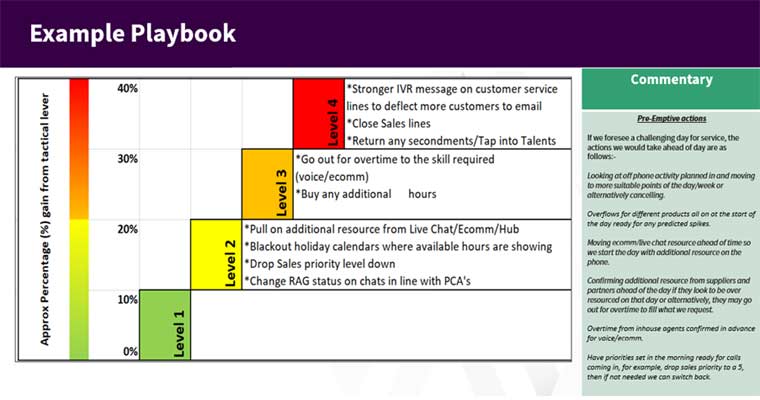Chris Hoye, Resource Planning Manager at Aviva, explains how creating a playbook can help you manage spikes in service demand.
What Is a Playbook?

A playbook is a formalized (written down) pre-agreed set of actions, which are put in place to boost available resource quickly if service levels are suddenly compromised.
It’s a best-practice initiative driven by thinking and agreeing what levers can be pulled across the wider business to get service back on track.
Without a playbook of pre-agreed actions, planning teams can lose precious time asking for help from other teams, getting approval from this manager or that team leader, and reviewing competing priorities – all the while service levels are spiralling out of control.
This can be a big support to those working to an ASA (Average Seconds to Answer) model, as it can recover service levels quickly before a spike compromises the weekly, or even monthly, target.
The Forum’s Best Practice Guide 2022 explains:
“In an uncertain and ambiguous situation, playbooks can focus us on what we would do under different scenarios and the potential impacts of these decisions. While we are analysing complex issues, we need to make our models simple for people to understand.
“Playbooks help us, and also make us more agile, because we engage everyone in advance, and agree the principles. Then we can roll out the agreed plan rapidly on the day, without further consultation.”
Example Playbook

How to Create a Playbook
Here are some simple steps to follow to create your playbook:
Be Clear About What You Are Trying to Achieve
You are not trying to create a mammoth document of minute detail, but instead a simple list of “if X happens, draw on Y team for additional resource”.
Draw on Previous Experience
You have very likely already experienced a lot of these situations and have a point of reference for how these were resolved. Take some time to think about what you already know.
Get Everyone Together
Put the playbook firmly on the agenda in your next (and ongoing) planning meeting. You need to have conversations and permissions agreed in advance with managers and team leaders, so bring everyone together to discuss these scenarios openly.
For easy ideas to keep your agents happy, engaged and productive during their meetings, read our article: 12 Ideas to Keep Agents Engaged During Meetings and Training Sessions
Write It Down
Once all the above is agreed, write it down! It can be a Word doc, Excel sheet or PowerPoint slide. Whatever you like.
You can also categorize these scenarios according to levels of urgency, or with a traffic light system, to outline the severity and amount of resource needed for each case. You should also create a list of names and contact details for everyone involved for ease of communicating.
Communicate
Share the document with managers who need to see it, and make sure to speak to the agents who are included in the plans too.
Review, Review, Review
A playbook should be treated as a living, breathing entity. It’s evolved through trial and error, so make sure you debrief and discuss as situations arise so you can adapt and build in key learnings.
Challenges to Pre-Empt
As with any operational action plan that spans departments, it is important that you pre-empt the challenges you are going to face, not only those that crop up when creating it, but those that can arise if you need to implement the actions.
To help with this, here are three of the general challenges you need to pre-empt, but you will need to identify others that apply to your specific business:
1. Getting Buy-In From the Agents / Additional Resource
Everyone is busy and has their own priorities. Even if their manager has nominated them, make time to talk to the people involved about their role in getting service levels back under control and the importance of it.
Resistance in the middle of a service crisis isn’t going to help anyone.
After all, resistance in the middle of a service crisis isn’t going to help anyone. With a good playbook and buy-in, additional resource can be mobilized very quickly to de-escalate any spikes in demand.
2. Voluntary vs. Mandatory
It can be tempting to make the process voluntary on a case-by-case basis, but this can leave you with a small team of volunteers who lose hours from their day trying to get service levels back on track.
Instead, get support from your Head of Operations to set the expectation that everyone will get involved and jump on the phones to help when they’re needed – unless they have a very good reason not to.
By taking this firmer, mandatory approach, it follows the idiom of ‘many hands make light work’ and ensures everyone involved can get back to their normal day as soon as possible.
3. Kit, Permissions and Refresher Training
Don’t forget to also prepare reserve teams with the kit they’ll need – from permissions to headsets – so they can jump on to help with calls as quickly as possible.
Again, having these pre-agreed conversations means that you can have these things in place, so it really is as simple as asking Bob for help and then he can switch on in a matter of minutes.
Another consideration is making sure anyone on a reserve list is also kept up to date with the latest legal requirements or any other training that they need.
This way, they don’t get left behind and recite outdated information to customers. Alternatively, you can build a quick refresher course into any playbook action plan.
How Much Does It Cost?
Making a playbook shouldn’t take any more time or resource than what you’d be doing anyway. It’s just a case of organizing the conversations and information you already have.
It’s about discussing it in the weekly planning meeting – reviewing assumptions, monitoring and more – as opposed to setting aside time for a dedicated meeting.
Additional Uses for Playbooks

Traditionally, playbooks have been used by Real-Time teams to flex supply and demand on the day.
However, the playbook concept has the potential to do a whole lot more, as Phil Anderson, Director at The Forum comments:
“The future of the playbook concept presents opportunities for documented plans of action for alternative scenarios across the business.
“This should mean there is a ‘Strategic Playbook’ to understand the changing landscape of customers, suppliers, and technology; a ‘Budget Playbook’ to support changing assumptions and impact on the budget; and a ‘Scheduling Playbook’ to offer choices for advisors and team leaders.
“Meanwhile, the operation plan should have a range of playbooks to understand recruitment, change initiatives, learning & development, and current versus projected performance.”
Thanks to Chris Hoye, Resource Planning Manager at Aviva, for this great article.
If you are looking for more helpful information to help you implement playbooks, read these articles next:
- Preparing for the Unexpected: How to Create a Business Continuity Plan
- 7 Clever Ways to Improve Internal Communication Between Departments
- Workforce Planning: 20 Fundamental Rules
Author: Robyn Coppell
Published On: 25th Jan 2023 - Last modified: 20th Aug 2025
Read more about - Workforce Planning, Communication Skills, Editor's Picks, Phil Anderson, Scheduling, Staffing, The Forum, Workforce Management (WFM), Workforce Planning





































